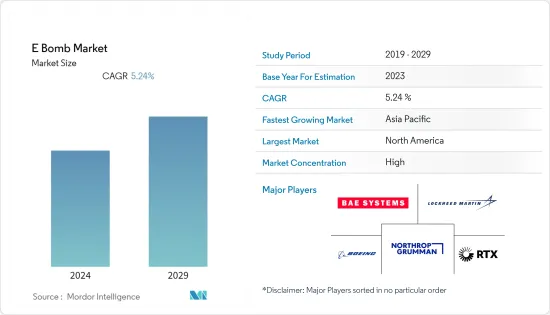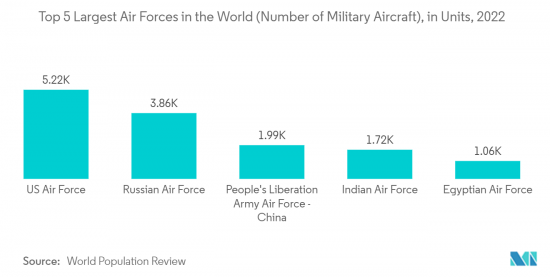
|
市場調査レポート
商品コード
1408581
Eボム:市場シェア分析、産業動向と統計、成長予測、2024~2029年E Bomb - Market Share Analysis, Industry Trends & Statistics, Growth Forecasts 2024 - 2029 |
||||||
カスタマイズ可能
適宜更新あり
|
|||||||
| Eボム:市場シェア分析、産業動向と統計、成長予測、2024~2029年 |
|
出版日: 2024年01月04日
発行: Mordor Intelligence
ページ情報: 英文 90 Pages
納期: 2~3営業日
|
全表示
- 概要
- 目次
Eボム市場は2024年に52億6,000万米ドルと評価され、2029年には68億米ドルに達すると予測され、予測期間中のCAGRは5.26%で成長すると予測されます。

電磁爆弾(E-bomb)は、電磁パルス(EMP)で電子機器や機械システムを停止させるように設計された高度な兵器です。電気/電子システムと結合し、有害な電流・電圧サージを発生させることができます。水爆は強力な電磁パルスを発生させ、通信システム、電子回路、人工衛星、コンピューター、変圧器など、電流に依存するもの、電流を伝達するものを永久に無力化します。目標を破壊したり、人を殺したりすることはないです。
ハイパワーマイクロ波(HPM)の使用の増加と、敵の移動目標、艦艇、移動レーダー、防空システム、その他の電子システムを標的とする軍事分野でのEボムの使用の増加が、予測期間中の市場成長の原動力となっています。現在、GPS誘導弾は戦略的航空攻撃に非常に有用であるため、需要が増加しています。GPS誘導弾は、より正確な誘導能力を提供する高度なセンサー、制御システム、および調整可能な飛行フィンを備えています。軍事技術の技術的進歩、次世代兵器の採用、防衛能力の強化に向けた支出の増加は、今後数年間の市場成長を促進します。その一方で、目標への運搬手段に関連するEボムの限界があります。Eボムの有効性は、兵器が到達し展開するための運搬プラットフォームの能力に完全に依存します。このような要因が市場の成長を妨げています。
Eボムの市場動向
空軍セグメントが予測期間中に最も高い成長を示すと予想される
空軍セグメントは予測期間中に顕著な成長を示すと思われます。この成長は、防衛分野への支出の増加、最新鋭戦闘機の調達の増加、敵の電子機器を標的とする次世代Eボムの採用によるものです。世界の軍事費は2022年に史上最高の2兆2,400億米ドルに達しました。国境を越えた紛争の増加、ロシア・ウクライナ戦争、近隣諸国の政治的紛争は、安全保障上の脅威の増大につながります。そのため、世界の国防軍は防衛能力の向上に大きく投資しています。
Eボムの主な利点は、GPS誘導弾の発射が可能な航法攻撃システムを搭載した戦術機であれば、どのような機体でも発射できることです。Eボムは数百万ワットのマイクロ波のエネルギーを発射することができ、電子機器やそれに依存する兵器をノックアウトすることができます。例えば、2023年6月、改良されたロシアの電子戦システムは、1カ月で約1万機のウクライナの無人機を破壊し、ウクライナの戦術通信をリアルタイムで傍受・解読することができました。このように、先進的なEボムの採用が進み、次世代戦闘機の調達への支出が増加していることが、予測期間中の市場の成長を後押ししています。

予測期間中は北米が市場を独占
北米は市場で最も高いシェアを占めており、予測期間中もその支配が続く。この成長は、米国政府による国防支出の増加、先進軍事兵器の調達の増加、最大の軍用機隊の存在によるものです。ストックホルム国際平和研究所(Stockholm International Peace Research Institute)は2022年に、米国は世界最大の国防支出国であり、国防予算は8,770億米ドルであるとする報告書を発表しました。米国国防総省(DoD)の2024年予算要求は、先進軍需品の調達に重点を置いた国家防衛戦略に重点を置いています。2024年の軍需予算は306億米ドルで、2023年の要求より58億米ドル増加しています。例えば、米国国防総省は指向性エネルギー集中型電磁エネルギー兵器の設計・開発に毎年10億米ドルを費やしています。現在、米国国防総省は、無人機やミサイルを含むさまざまな脅威を撃退する目的で、指向性エネルギー兵器を開発しています。さらに、各省庁は、軍事基地に対するミサイルやドローンの大群攻撃に対処するためなど、さまざまな用途に対応する高出力マイクロ波能力を開発しました。このように、安全保障上の脅威の高まりによる先端兵器の調達への支出の増加と、防衛能力の向上への注目の高まりが、この地域全体の市場成長を促進しています。
Eボム産業の概要
Eボム市場は非常に断片化されており、少数のプレーヤーが市場で大きなシェアを占めています。市場の主なプレーヤーには、Boeing Company、Raytheon Technologies Corporation、Lockheed Martin Corporation、Northrop Grumman Corporation、BAE Systems plc.などがあります。主な相手先商標製品メーカー(OEM)は、技術的な発展や、精度と信頼性を向上させた高度なEボムの設計開発に非常に注力しています。例えば、2019年9月、ノースロップ・グラマン・コーポレーションは、米国海軍からFMU-139D/Bを製造する最初の生産注文を受けました。これは、米国国防総省とその同盟国が使用する多くの汎用爆弾に適した新しい全Eボムフューズです。
その他の特典:
- エクセル形式の市場予測(ME)シート
- 3ヶ月のアナリストサポート
目次
第1章 イントロダクション
- 調査の前提条件
- 調査範囲
第2章 調査手法
第3章 エグゼクティブサマリー
第4章 市場力学
- 市場概要
- 市場促進要因
- 市場抑制要因
- ポーターのファイブフォース分析
- 供給企業の交渉力
- 買い手・消費者の交渉力
- 新規参入業者の脅威
- 代替品の脅威
- 競争企業間の敵対関係の強さ
第5章 市場セグメンテーション
- エンドユーザー
- 陸軍
- 海軍
- 空軍
- タイプ
- 核兵器
- 非核
- 地域
- 北米
- 米国
- カナダ
- 欧州
- 英国
- フランス
- ドイツ
- ロシア
- その他欧州
- アジア太平洋
- 中国
- インド
- 日本
- 韓国
- その他アジア太平洋地域
- ラテンアメリカ
- ブラジル
- その他ラテンアメリカ
- 中東・アフリカ
- サウジアラビア
- アラブ首長国連邦
- エジプト
- その他中東とアフリカ
- 北米
第6章 競合情勢
- 企業プロファイル
- General Dynamics Corporation
- Lockheed Martin Corporation
- BAE Systems plc
- The Boeing Company
- Northrop Grumman Corporation
- RTX Corporation
- Denel SOC Ltd.
- Textron Inc.
- L3Harris Technologies, Inc.
- Defense Research and Development Organization(DRDO)
第7章 市場機会と今後の動向

The E-Bomb market is valued at USD 5.26 billion in 2024 and is expected to reach 6.8 billion by 2029, projecting a CAGR of 5.26% during the forecast period.
An electromagnetic bomb (E-bomb) is an advanced weapon designed to turn off electronics and mechanical systems with an electromagnetic pulse (EMP). It can couple with electrical/electronic systems to produce damaging current and voltage surges. E-Bomb generates a powerful EMP that permanently disables telecommunications systems, electronic circuitry, satellites, computers, electrical transformers, and anything that relies on or transmits electrical current. It does not destroy targets or kill people.
The increasing use of high-power microwaves (HPM) and the rising use of E-bomb in the military sector as they target the enemy's mobile targets, naval vessels, mobile radars, air defense systems, and other electronics systems is driving the growth of the market during the forecast period. Nowadays, there is increased demand for GPS-guided munitions as these are highly useful in strategic air attacks. The GPS-guided munition is equipped with advanced sensors, control systems, and adjustable flight fins that provide more accurate guidance capacity. Technological advancements in military technology, the adoption of next-generation weapons, and rising spending on enhancing defense capabilities will drive market growth in the coming years. On the other hand, there is a limitation of the E bomb related to its means of delivery to the target. The effectiveness of an E bomb completely depends on the delivery platform's ability to reach and deploy the weapon. Such factors hinder the growth of the market.
E Bomb Market Trends
Air Force Segment is Expected to Show Highest Growth During the Forecast Period
The Air Force segment will showcase remarkable growth during the forecast period. The growth is due to the increasing expenditure on the defense sector, growing procurement of advanced fighter jets, and adoption of next-generation e-bomb to target the electronic devices of enemies. Global military spending reached an all-time high of USD 2.24 trillion in 2022. Increasing cross-border conflicts, the Russia-Ukraine war, and political disputes in neighboring countries lead to increasing security threats. Thus, global defense forces are highly investing in improving their defense capabilities.
The major advantage of electromagnetic bombs is that they can be delivered by any tactical aircraft with a nav-attack system capable of delivering GPS-guided munitions. E-bombs can fire millions of watts of energy in microwaves that can knock out electronic equipment and the weapons that rely on them. For instance, in June 2023, an improved Russian electronic warfare system destroyed about 10,000 Ukrainian drones in a month and was able to intercept and decrypt Ukrainian tactical communications in real-time. Thus, the growing adoption of advanced E-bombs and rising spending on procurement of next-generation fighter jets is boosting the growth of the market during the forecast period.

North America Dominates the Market During the Forecast Period
North America holds the highest shares in the market and continues its domination during the forecast period. The growth is due to increased defense spending from the US government, rising procurement of advanced military weapons, and the presence of the largest military aircraft fleet. The Stockholm International Peace Research Institute published a report in 2022 that stated that the US is the largest defense spender in the world, with a defense budget of USD 877 billion. The US Department of Defense (DoD) 2024 budget request is focused on national defense strategy with more emphasis on procurement of advanced munition. The 2024 budget for munitions is USD 30.6 billion, an increase of USD 5.8 billion above the 2023 request. For instance, the US DoD spends USD 1 billion annually on the design and development of directed energy-concentrated electromagnetic energy weapons. Currently, the US DoD is developing directed energy weapons with the goal of defeating a range of threats, including drones and missiles. Furthermore, the departments developed a range of high-power microwave capabilities for various applications, such as engaging missile or drone swarm attacks against a military base. Thus, growing expenditure on procurement of advanced weapons due to rising security threats and increased focus on improving defense capabilities is driving the market growth across the region.
E Bomb Industry Overview
The E-bomb market is highly fragmented, with a presence of few players holding significant shares in the market. Some of the key players in the market are The Boeing Company, Raytheon Technologies Corporation, Lockheed Martin Corporation, Northrop Grumman Corporation, and BAE Systems plc. Key original equipment manufacturers (OEMs) highly focus on technological advancements and the design and development of advanced electromagnetic bombs with improved accuracy and reliability. For instance, in September 2019, Northrop Grumman Corporation received its first production order from the US Navy to manufacture the FMU-139D/B. It is a new all-electronic bomb fuze suitable for a number of general-purpose bombs used by the US Department of Defense and its allied nations.
Additional Benefits:
- The market estimate (ME) sheet in Excel format
- 3 months of analyst support
TABLE OF CONTENTS
1 INTRODUCTION
- 1.1 Study Assumptions
- 1.2 Scope of the Study
2 RESEARCH METHODOLOGY
3 EXECUTIVE SUMMARY
4 MARKET DYNAMICS
- 4.1 Market Overview
- 4.2 Market Drivers
- 4.3 Market Restraints
- 4.4 Porter's Five Forces Analysis
- 4.4.1 Bargaining Power of Suppliers
- 4.4.2 Bargaining Power of Buyers/Consumers
- 4.4.3 Threat of New Entrants
- 4.4.4 Threat of Substitute Products
- 4.4.5 Intensity of Competitive Rivalry
5 MARKET SEGMENTATION
- 5.1 End User
- 5.1.1 Army
- 5.1.2 Navy
- 5.1.3 Air Force
- 5.2 Type
- 5.2.1 Nuclear
- 5.2.2 Non-Nuclear
- 5.3 Geography
- 5.3.1 North America
- 5.3.1.1 United States
- 5.3.1.2 Canada
- 5.3.2 Europe
- 5.3.2.1 United Kingdom
- 5.3.2.2 France
- 5.3.2.3 Germany
- 5.3.2.4 Russia
- 5.3.2.5 Rest of Europe
- 5.3.3 Asia-Pacific
- 5.3.3.1 China
- 5.3.3.2 India
- 5.3.3.3 Japan
- 5.3.3.4 South Korea
- 5.3.3.5 Rest of Asia-Pacific
- 5.3.4 Latin America
- 5.3.4.1 Brazil
- 5.3.4.2 Rest of Latin America
- 5.3.5 Middle East and Africa
- 5.3.5.1 Saudi Arabia
- 5.3.5.2 United Arab Emirates
- 5.3.5.3 Egypt
- 5.3.5.4 Rest of Middle East and Africa
- 5.3.1 North America
6 COMPETITIVE LANDSCAPE
- 6.1 Company Profiles
- 6.1.1 General Dynamics Corporation
- 6.1.2 Lockheed Martin Corporation
- 6.1.3 BAE Systems plc
- 6.1.4 The Boeing Company
- 6.1.5 Northrop Grumman Corporation
- 6.1.6 RTX Corporation
- 6.1.7 Denel SOC Ltd.
- 6.1.8 Textron Inc.
- 6.1.9 L3Harris Technologies, Inc.
- 6.1.10 Defense Research and Development Organization (DRDO)

